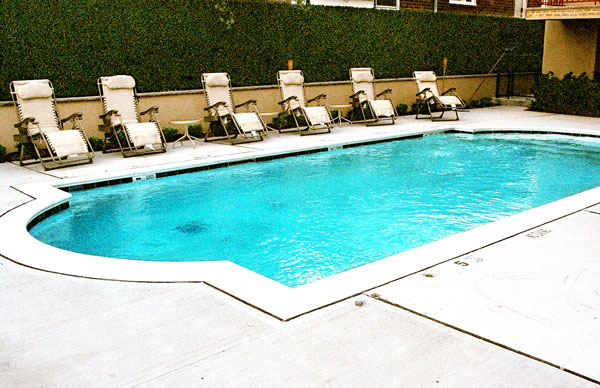English phrases for talking about swimming

Phrases to describe the activity of swimming
- Go swimming
- Go for a swim
- Go for a dip (in the pool, in the ocean, etc.)
- Take a dip (in the pool, in the ocean, etc.)
- Jump in the pool
Places to swim
- A "public pool" is available for anyone to swim in, sometimes for free and sometimes for a charge.
- An "indoor pool" is inside a building.
- A "kiddie pool" is a small pool that you can buy at a store and put in your yard. It's for small children to play in.
- A "hot tub" has hot water. You don't swim in it exactly, but just sit in it. If it has jets that make bubbles in the water, it's called a "jacuzzi".
- A "public access beach" is one that anyone can swim at. A "secluded beach" is one that's far away from cities or towns, and that you can swim at alone.
- You can also swim in the ocean, at a lake, in a river, and so on.
Swimming gear
- Men in the U.S. wear swimming trunks to swim. These are shorts that are made of a material that dries quickly. Some men wear speedos, which are small, tight swimming pants. But it's not common to wear speedos for casual swimming; they're mostly for competitive swimmers. A lot of people think speedos are gross!
- Women wear bathing suits. Technically, you can call men's swimming trunks a "bathing suit" as well, but usually it just means a women's bathing suit. Types of bathing suits for women include:
- Bikinis are bathings suits that come in two pieces.
- One-piece bathing suits cover the whole chest and stomach area.
- Some people use swim goggles.
- Little children wear floaties. These are air-filled floats that go around your arms.
Ways of getting into the water
- If the water is cold, you might try to ease into it. This means getting in slowly and gradually. Or you might just wade in the water, which means standing in the water up to your legs or waist without putting your whole body into the water.
- You can jump into the water in different ways:
- Jump in feet-first.
- Dive in. When you enter the water with your head facing toward the water, it's called "diving". You can dive off of a diving board, the edge of a pool, a dock on a lake or river, or if you're really adventurous, off of a cliff.
- Do a somersault into the water. This is when you jump and flip your body completely forward or backward.
- When you jump into the water and your body hits the surface flat against your stomach and face, it can be very painful. This is called "belly flopping".
- Sometimes people try to make a huge splash when they jump in the water. One way to do this is to do a cannoball. This is when you curl your body into a ball shape when you jump in.
Want more English phrases for talking about swimming? Join PhraseMix Premium to learn about:
Styles of swimming
Swimming safety
Describing the water
Styles of swimming
- When kids first learn to swim, they usually start with doggy paddling. This is when you just paddle your hands quickly in front of you and kick your legs a little.
- Later, you may learn to use more advanced strokes. "Strokes" are different methods of swimming. For example:
- The "breast stroke" is when you start with your arms together in front and draw them back in a wide circular motion. Your head can be down in the water or up above the water.
- The "back stroke" is when you float on your back and swing one arm at a time up over your head, then pull it down toward your body again through the water.
- A crawl is the fastest style of swimming. When you swim in a crawl, you face down into the water and swing one arm at a time up past your shoulders, then pull it toward your body through the water.
- Something else you can do in the pool is tread water. "Treading water" means moving your hands and feet around so that you don't move forward, but don't sink.
- People who swim for exercise sometimes swim laps. This means swimming back and forth quickly across a pool.
- If someone swims well, you call them "a strong swimmer". A person who can't swim as well is "a weak swimmer".
Swimming safety
- Some pools and beaches have a lifeguard on duty. A lifeguard watches the water and makes sure that no one drowns.
- Most pools have rules posted. Common rules include:
- "Swim at your own risk." This means that the pool owner isn't responsible if you injure yourself or drown.
- "Children under twelve must be accompanied by an adult."
- "No running on the deck." ("The deck" is the area around the pool.)
- "No horseplay." (This means doing things like throwing people in the pool, splashing people, chasing someone, wrestling in the water, etc.)
- When you swim in the ocean, you should be careful of the undertow. This is a current which pulls you out toward the sea.
Describing the water
- Pool water is usually chlorinated. Chlorine is a chemical that people put in pool water to keep it clean.
- If you can see through the water in an ocean, river, or lake, you can describe it as "clear" or "crystal clear".
- Water that you can't see through is "murky".
- A lot of pools have a shallow end and a deep end.





